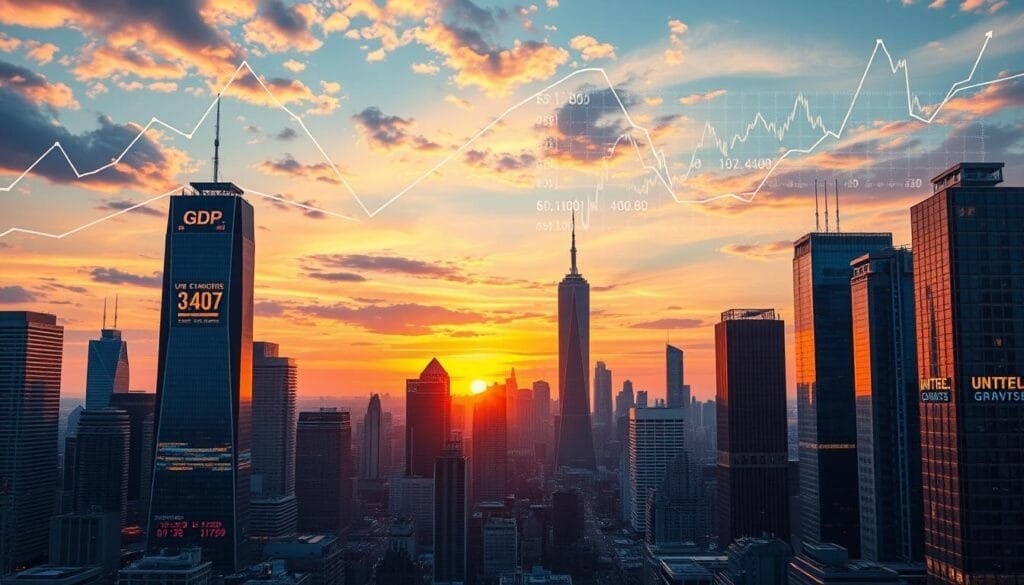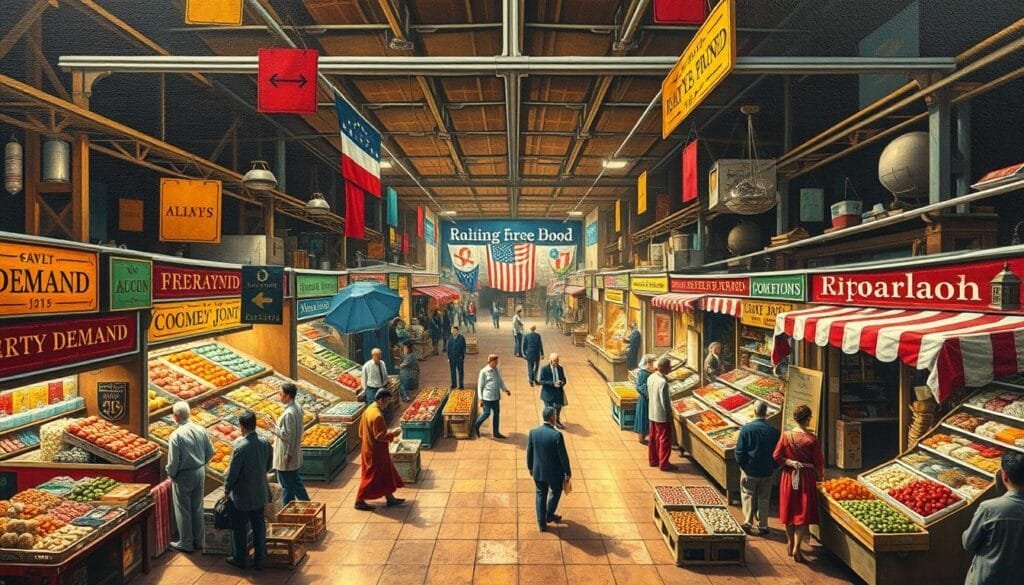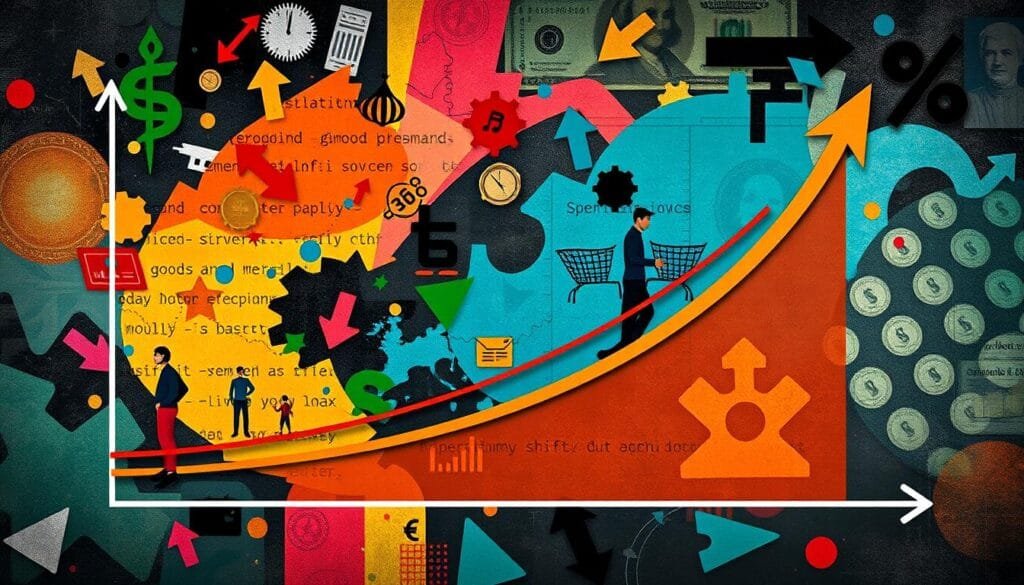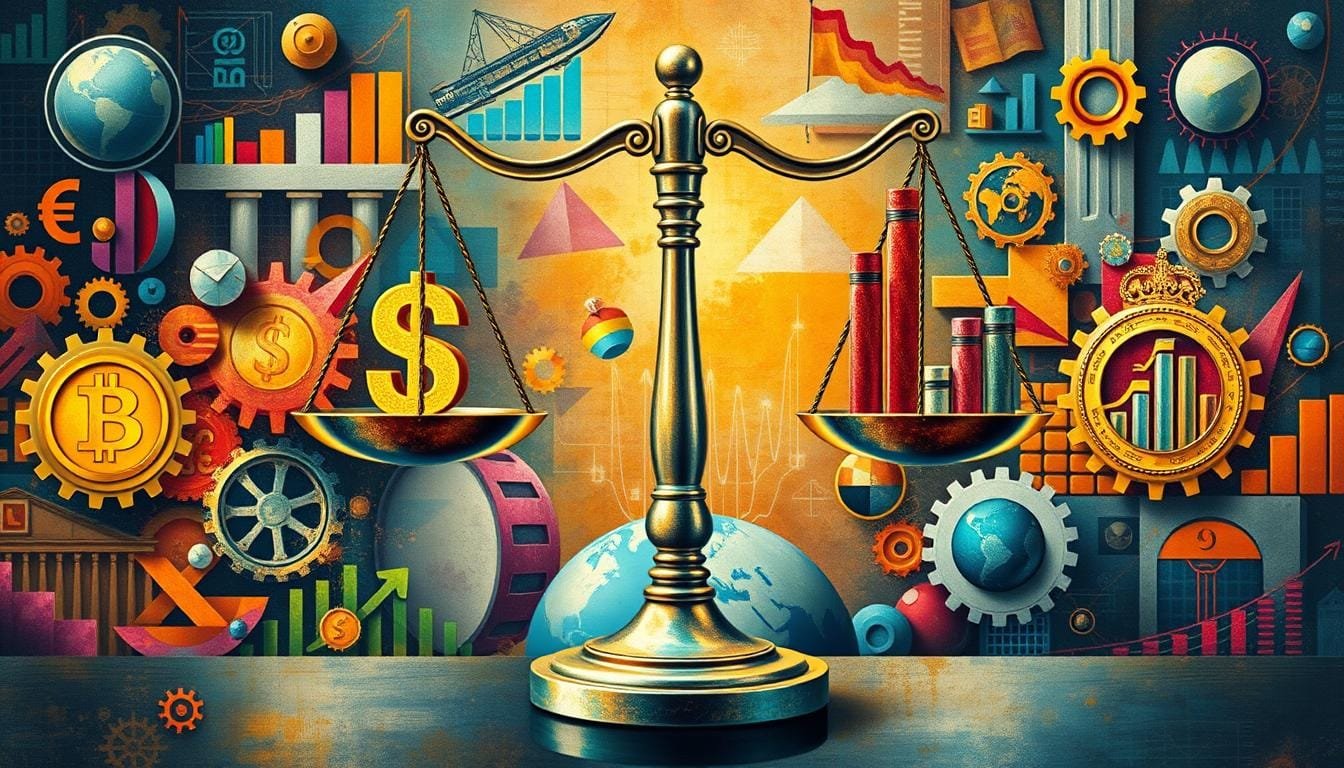Have you ever thought about how knowing basic economics can change how we make daily choices? Economics looks at how people and groups use what they have wisely. This subject affects our lives every day and has two main parts: microeconomics and macroeconomics.
With this easy guide to economics, we want to make the topic clear. Our goal is to make economic principles easy for everyone to understand.
In the United States, 38% of economists work for government agencies. This highlights how vital economics is in creating public policy. Also, since over two-thirds of the Gross Domestic Product (GDP) comes from what we buy, it’s key to understand these economic ideas.
Having a basic knowledge of economics can help you in many fields. It can lead to opportunities in finance, government, and more. Knowing about supply and demand or how inflation works is really helpful.
Key Takeaways
- Economics is about how people and groups utilize limited resources.
- 38% of U.S. economists work for government agencies.
- Consumer spending makes up over two-thirds of GDP.
- Understanding economics can aid in navigating various career fields.
- This guide will simplify complex economic concepts for everyday use.
What is Economics?
Economics explores how people, companies, and governments use their limited resources. It looks at the choices made when resources are not enough. This means deciding what’s most important to use them for.
Definition of Economics
The definition of economics focuses on how we distribute scarce resources for different needs. Lionel Robbins described it as the study of choices when resources can have many uses. It connects with many fields like political science, psychology, and even medicine.
The Role of Scarcity
Economic scarcity is about not having enough resources to meet all wants. It makes people and societies choose how to use what they have wisely. For example, countries that grow economically are usually better at managing their resources.
Wants vs. Needs
It’s important to know the difference between economic wants and needs. Needs are things we must have to live, like food and shelter. Wants are extras that make life more enjoyable.
| Aspect | Needs | Wants |
|---|---|---|
| Definition | Essential for survival | Desired for comfort and pleasure |
| Examples | Food, water, housing | Luxury cars, vacations, gadgets |
| Impact on Allocation | Primary focus under scarcity | Secondary focus after needs are met |
In conclusion, understanding economic scarcity and the balance between wants and needs is key. This knowledge helps us make smart choices for a better future.
The Two Main Branches of Economics
Economics is divided into two main parts: Microeconomics and Macroeconomics. They help us understand economic issues. This spans from individual choices to big economic policies.
Microeconomics
Microeconomics looks at how individual parts like households and businesses make decisions. It studies how they use resources and set prices for what they sell or buy. This is based on supply and demand.
Economic equilibrium happens when demand equals supply, making prices stable. For example, if more people want a product, its price goes up. But if there’s more of the product than people want, the price goes down. This also affects stock market prices.
Macroeconomics

Macroeconomics, on the other hand, looks at the whole economy and bigger industries. It checks factors like the total goods and services produced, job rates, and a country’s income. This field looks at big picture items like how much money a country makes and how many people are jobless.
It studies big measures to understand ups and downs in the economy, trade with other countries, and government decisions. The Great Recession of 2008–09 is an example. It shook financial institutions and made governments think again about their policies. The early 2020 market crash, due to the pandemic, is another. Government actions helped the stock market recover by the end of 2020.
| Aspect | Microeconomics | Macroeconomics |
|---|---|---|
| Focus | Individual decision-making processes | Entire economies and industries |
| Key Elements | Resource allocation, pricing, supply and demand | GDP, national income, unemployment |
| Examples | Stock prices, consumer behavior | Economic cycles, government policies |
In brief, both Microeconomics and Macroeconomics are key to grasping how economies work. They offer insights into big and small economic issues. This includes understanding inflation, poverty, and lack of jobs.
Understanding Supply and Demand
Supply and demand are key economic concepts. They determine how much goods cost and how available they are. Markets find balance and stability through this. This affects everything from what we buy to how businesses plan.
Basic Principles of Supply and Demand
If a product’s price goes up, people usually want it less. But if the price falls, more people want it. This is true for different markets and goods.
- Giffen Goods: Demand increases with price because they’re seen as inferior goods.
- Veblen Goods: Higher prices make them more desired for their status symbol.
The law of supply connects price with how much of a good is made. Producers make more when prices are high. They make less when prices are low. The perfect balance is when the amount made matches what people want, keeping prices stable.

Factors Affecting Supply and Demand
Many things change how much of something people want and how much is made.
- Consumer Income: When people earn more, they buy more.
- Technological Innovations: New tech can change costs and what people like.
- Resource Availability: Not enough of something means it gets more expensive.
For instance, when COVID-19 hit, less gasoline was used. This made its price drop and changed how much companies made.
Real-World Examples
The housing market shows how supply and demand work. House prices change with how many are for sale and how many people want to buy. Oil and farm products also show big price changes for these reasons.
| Example | Demand Response | Supply Response |
|---|---|---|
| Television Pricing | High prices reduce consumer demand | Low prices discourage production |
| Housing Market | High demand raises prices | Limited supply increases competition |
| Oil Prices | Global events impact demand | Resource availability affects supply |
These examples show how supply and demand shape markets. They influence the cost and availability of goods in every sector. Knowing about these principles helps us understand and forecast market actions.
The Concept of Elasticity
Elasticity measures how one thing reacts to changes in another. It’s important in economics, especially for understanding demand. This concept helps businesses and decision-makers.

Price Elasticity of Demand
Price elasticity shows how demand changes with price. It lets us see how sensitive the market is. For example, elastic products see big demand shifts with price changes.
In the airline sector, demand is highly elastic. If an airline raises prices, fewer people choose it. Yet, gasoline shows low elasticity. People need it, so they buy even if it’s more expensive.
Applications of Elasticity in Everyday Life
Elasticity helps set prices effectively. The supply principle suggests supply goes up when prices do, and down when prices drop. This guides businesses on pricing for more profit.
The income elasticity of demand tracks how needs change with income. Luxury items are more in demand when people earn more. Basic goods like bread don’t change much in demand with income changes.
Cross-price elasticity looks at substitutes. It sees how a coffee price increase might not lower tea demand much, if at all. It shows competition through market responsiveness.
| Elasticity Type | Characteristic | Example |
|---|---|---|
| Price Elasticity of Demand | Measures demand change with price | Airline tickets |
| Income Elasticity of Demand | Measures demand change with income | Luxury goods |
| Cross-Price Elasticity | Measures demand change with substitute goods | Tea vs. coffee |
Understanding elasticity helps predict economic changes. It leads to stronger market strategies and smarter pricing.
Economic Indicators: GDP, Inflation, and More
Economic indicators are key to understanding a country’s economic health. Experts use these to predict trends and measure the economy’s state. They look at GDP and inflation to guide future economic plans.
Gross Domestic Product (GDP)
GDP is a major measure of economic health. It calculates the value of all goods and services made within a country during a certain time. This includes consumer spending and government purchases. It shows how much the economy is growing.
The BEA reports real GDP by taking out inflation from the nominal GDP. This gives a true picture of the economy. GDP figures are released every three months. This helps keep track of how the economy is doing.
Understanding Inflation and Deflation
Inflation and deflation show how prices change over time. The Fed aims for a 2% inflation rate to keep prices stable. The CPI measures how prices for certain goods and services move every month.
Deflation means prices are falling. This might sound good, but it can hurt the economy by decreasing spending and investment. Keeping an eye on inflation helps understand buying power and economic choices.
| Indicator | Description | Frequency |
|---|---|---|
| GDP | The total value of all goods and services produced | Quarterly |
| Consumer Price Index (CPI) | Measures inflation for a basket of consumer goods and services | Monthly |
| Personal Consumption Expenditures (PCE) | Tracks price changes for consumer goods and services | Monthly |
| Unemployment Rate | The percentage of unemployed actively seeking work | Monthly |
The Role of Government in the Economy
The government plays a key role in the economy. Through fiscal policy and economic regulation, it aims for stable growth and employment. Understanding these contributions offers insights into the economy’s well-being.
Fiscal Policies
Fiscal policy is crucial for steering the economy. It involves adjusting government spend and tax rates. For example, it uses progressive taxation to lessen inequality by taxing the rich more than the poor.
Government strategies, like tax policies and subsidies, stabilize the economy. Taxes on pollutants and subsidies for education are examples. They correct market flaws.
Changes in public spend, tax rates, or incentives can boost growth or slow down an overactive economy. The Federal Reserve also plays a role through the Federal Funds Rate and buying or selling government securities.
Regulation and Public Goods
Providing public goods and services is another key government role. Examples include national defense and public infrastructure. These are essential for society’s smooth running.
The government uses regulation to ensure fair play and curb market abuses. It keeps markets competitive and protects consumers. Addressing pollution, monopolies, and fraud requires strong oversight.
The government also maintains a legal framework to uphold laws and contracts. This setup is vital for a stable, well-functioning economy. Thus, government responsibilities extend to regulation, and ensuring access to crucial public goods.
What is Economics Paraphrased: Making Choices with Limited Resources
Economics is about making smart choices when we don’t have everything we want. The “economizing problem” focuses on how to use our limited resources best. Even in rich countries like the US, this shows why understanding economics is always important.
Choosing wisely is key in economics. We always have to decide what needs or wants come first since our resources are limited. Individuals, for example, have to plan their daily spending, just as governments need to decide on policies for things like renewable energy. Every decision means giving up other options, introducing the concept of opportunity cost.
- Growing the economy – we try to make more goods and services. This can happen by getting more resources, making them better, or using new tech.
- Wanting less – we try to adjust our wishes to what we have.
- Being smart with what we have – we aim to use our resources in the best way to be productive and limit waste.
Economic growth helps us beat scarcity. We can make more goods and services by either getting more resources, improving their quality, or using better technology. Being productive at the lowest cost is critical here. It helps us save resources and produce more.
When we use resources well, it shows in high employment rates. This is a sign of economic fairness. But if we’re not efficient, scarcity gets worse and everyone’s less happy.
Every day, we make lots of economic choices. Students, for example, might learn about opportunity costs through exercises. These lessons show how important it is to understand economic principles in real life.
Scarcity affects different parts of the market too. The balance between managers and workers in the labor market is one example. Also, natural resources might seem plenty but can run out if we use them too much. The increasing cost of keeping the air clean is a clear sign of this.
In the end, understanding economics helps us deal with complex situations. It guides our personal spending, policy decisions, or how we react to market changes. The principles of economics help us use our limited resources to get the most satisfaction.
Conclusion
Understanding economics is crucial in today’s complex world. Adam Smith, Alfred Marshall, Lionel Robbins, and Paul Samuelson shared key insights. They taught us about scarcity, the importance of trade, and how economies operate. Smith looked at wealth, while Marshall considered human behavior. Robbins focused on scarce resources. Samuelson brought a modern angle to these ideas.
Economics is about choosing how to use limited resources. It covers both small-scale interactions and whole economic systems’ operations. On a small scale, we look at individual actions in markets. On a larger scale, we study how societies produce, distribute, and use goods and services.
Understanding supply and demand, elasticity, and indicators like GDP and inflation helps us make better decisions. These economic concepts help in many areas, such as healthcare and government. For a deeper look at economics, check out this overview of economic principles.
By learning about economics, we help ourselves and our communities. We learn how to manage resources and make smart choices. We understand how public policies affect our economy. This knowledge improves our financial well-being and supports societal health. Let’s use economic principles to make wise choices daily. This way, we can understand our economic impact and help create a better world.
FAQ
What is Economics?
Economics studies how people, businesses, and governments use resources. It looks at how they make choices to meet needs and wants when resources are scarce.
What is the Role of Scarcity in Economics?
Scarcity means having limited resources in a world of endless wants. It makes us decide the best way to use these resources.
What is the Difference Between Wants and Needs?
Needs are essentials like food, water, and shelter. Wants are all the other things we wish for but don’t need to survive.
What are the Two Main Branches of Economics?
Microeconomics looks at small-scale decisions about resources and prices. Macroeconomics studies large economic factors like national growth.
What are the Basic Principles of Supply and Demand?
Supply and demand explain how the availability of goods and people’s desires determine prices. Prices stabilize when supply meets demand.
What Factors Affect Supply and Demand?
Things like resource availability, tech advances, and what consumers want affect supply and demand. These can shift market prices.
Can You Provide a Real-World Example of Supply and Demand?
In the housing market, high demand and low supply push prices up. But if more homes are available than needed, prices drop.
What is Elasticity in Economics?
Elasticity measures how demand for a product changes with things like price. For example, price elasticity shows demand variation with price changes.
How Does Elasticity Apply to Everyday Life?
Knowing about elasticity helps set prices for goods and services. It affects things like fuel costs and public transport tickets.
What are Economic Indicators, and Why Are They Important?
Indicators like GDP and inflation show a country’s economic health. GDP indicates economic activity by measuring total goods and services produced.
How Do Governments Influence the Economy?
Governments can adjust the economy with rules, spending, and taxes. They use fiscal policies to guide economic conditions.
What is the Essence of Economics?
Economics is about choosing how to use limited resources. It’s finding how to best fulfill our needs and wants when resources are few.
